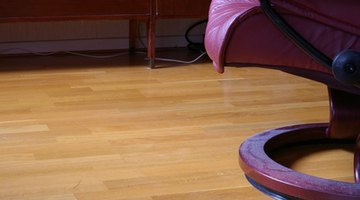How to Install Traffic Master Glueless Laminate Flooring
A glueless laminate floor is one of easiest and most versatile kinds of flooring you can lay. The idea is that the laminated boards of the flooring link together to each other, but aren't attached to the house in the any way; they're just pinned under the floor trim at the edges.

Glueless laminate flooring can go over just about any other floor material except carpeting. Traffic Master is a brand of glueless laminate flooring touted for its affordability and durability.
Things You Will Need
- Prybar
- Hammer
- Padded underlayment
- Plastic flooring tape
- Utility knife
- Traffic Master glueless laminate flooring
- Miter saw
- Table saw
- Trim nailer
-
Remove the floor trim with a prybar and hammer. Keep it intact as you remove it so you can reuse it.
-
Lay out your underlayment in course over the whole floor, starting along one wall. Cut it as needed with a utility knife. Tape the courses together along their edges with plastic flooring tape.
-
Lay the first course of Traffic Master floorboards along one wall, so the grooved sides of the floorboards face the wall. Leave a half an inch of space at the wall. (This will allow the floor to expand with environmental changes.) Link the boards at their ends, cutting the last one to fit against the perpendicular wall.
-
Set the next courses in place, linking the boards along their sides. Go course by course across the floor, making sure the ends don't line up. (Your Traffic Master flooring will come in varied board-lengths to help with this.) Cut the end pieces as needed on your miter saw.
-
Cut the final course of boards along their lengths using a table saw, so it leaves a half-inch gap there. Set your floor trim back in place so it covers up the gaps, securing it with a trim-nailer.
Warning
Wear eye protection when cutting your Traffic Master boards.
The Drip Cap
- A glueless laminate floor is one of easiest and most versatile kinds of flooring you can lay.
- Glueless laminate flooring can go over just about any other floor material except carpeting.
- Cut the end pieces as needed on your miter saw.
- Cut the final course of boards along their lengths using a table saw, so it leaves a half-inch gap there.
Photo Credits
- Floor image by Einar Bog from Fotolia.com
- Floor image by Einar Bog from Fotolia.com
More Articles



